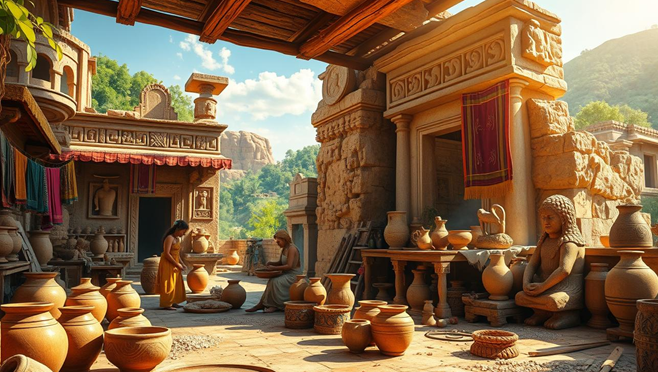Ancient Art Examples: A Journey Through Time
Greetings and welcome to Characteristics of ancient art, your go-to source for exploring the timeless pieces that have shaped the history of civilizations. Ancient Artz isn’t merely about aesthetics; it offers a window into the cultural, spiritual, and social landscapes of long-gone societies. The art of ancient civilizations is more than just sculptures or paintings; it’s an essential means of storytelling that reflects the values, beliefs, and worldviews of the people who created them.
In this article, we will explore some remarkable examples of Ancient Artz, diving into the materials, techniques, and stories behind these iconic creations. From the grand structures of Egypt to the intricate mosaics of Rome, each piece holds a story, a legacy, and a glimpse into the past. So, let’s begin our journey through time and discover the depth of human creativity that continues to inspire us today.
Egypt
Ancient Egypt is renowned for its rich cultural heritage, and its art is among the most enduring in human history. From the pyramids to the detailed paintings on tomb walls, Egyptian art is all about symbolism, order, and an understanding of the afterlife. One of the most iconic examples of Egyptian art is the Great Pyramid of Giza, a monumental structure that serves as both a tomb and a symbol of the divine power of Pharaohs. The pyramids were constructed with precise mathematical and architectural knowledge, showcasing the Egyptians’ advanced understanding of engineering.
Another striking example is the Bust of Nefertiti, a sculpture of Queen Nefertiti that remains a symbol of elegance and beauty. This limestone bust, discovered in 1912, is celebrated for its stunning craftsmanship and detailed portrayal of the queen’s regal features. The use of color and symmetry reflects Egyptian ideals of beauty and perfection.
Greece
Greek art is known for its exploration of human form, emotion, and the ideals of beauty and proportion. The Parthenon in Athens stands as a grand testament to Greek achievement in architecture. Dedicated to the goddess Athena, the temple is renowned for its Doric design and the intricate sculptures adorning its pediments and friezes. The Parthenon Marbles, including the famous Elgin Marbles, depict scenes from Greek mythology, demonstrating the Greeks’ profound interest in the divine and the heroic.
Greek sculpture, especially from the Classical period, focuses on idealized human forms. A prime example is the Venus de Milo, a Hellenistic sculpture that depicts the goddess Aphrodite. The graceful proportions and balance of the figure make it one of the most celebrated works of ancient Greek art, embodying the Greek pursuit of perfection in the human body.
Rome
Roman art, while heavily influenced by the Greeks, brought its own innovation, particularly in portraiture and architecture. Romans were known for their realistic portrayal of individuals, as seen in the Bust of Julius Caesar, which captures the distinct facial features and expression of one of Rome’s most famous leaders. Unlike the idealized figures of Greek art, Roman portraits emphasize age, wisdom, and experience, adding a sense of authenticity and character to their subjects.
In addition to sculpture, the Romans excelled in architectural feats, such as the Colosseum in Rome. This massive amphitheater was an engineering marvel, built to hold tens of thousands of spectators. It not only served as a venue for gladiatorial contests but also symbolized the grandeur of the Roman Empire. The Colosseum’s intricate design and advanced construction techniques reflect Roman society’s values of entertainment, power, and order.
China
Ancient Chinese art is deeply intertwined with spirituality, philosophy, and a reverence for nature. The Terracotta Army in Xi’an is perhaps the most famous example of ancient Chinese art, offering a glimpse into the grandeur of the First Emperor’s tomb. These thousands of life-sized figures, each with unique facial expressions and attire, were crafted to accompany the emperor into the afterlife. The precision and craftsmanship involved in the creation of the Terracotta Army demonstrate the advanced artistic and technological capabilities of ancient China.
Chinese art also emphasizes the connection between humanity and nature. Traditional Chinese landscape painting from the Tang and Song dynasties illustrates serene, natural scenes, often depicting mountains, rivers, and trees. These paintings reflect the Daoist belief in the harmony between humans and the natural world, an idea that permeates much of Chinese culture and art.
Mesopotamia
Mesopotamia, often regarded as the cradle of civilization, has a wealth of Ancient Artz that reflects the early development of society, religion, and politics. The Ishtar Gate of Babylon, with its vibrant blue tiles and depictions of animals such as lions and bulls, is a stunning example of Mesopotamian architecture and artistry. The gate was built in honor of the goddess Ishtar, showcasing the importance of religion in everyday life.
Another significant piece is the Standard of Ur, a rectangular box adorned with mosaics that illustrate scenes of war and peace. The art on the Standard of Ur gives insight into the social structure of ancient Mesopotamia, where warfare and diplomacy were crucial components of royal authority.
India
In ancient India, art was often linked to religious and spiritual beliefs, particularly in Hinduism and Buddhism. The Ajanta Caves in Maharashtra are a prime example of Buddhist art, with their intricate murals and sculptures that tell stories of the Buddha’s life and teachings. These cave paintings, which date back to the 2nd century BCE, are some of the earliest examples of Indian religious art.
Another notable example of ancient Indian art is the Temple of Kailasa in Ellora. Carved from a single piece of rock, this monumental structure is a marvel of engineering and artistry. The temple complex is adorned with detailed sculptures depicting scenes from Hindu mythology, showcasing the spiritual and artistic richness of ancient India.
Mesoamerica
Mesoamerican civilizations, such as the Maya and Aztecs, created art that was deeply connected to their religious and cosmological beliefs. The Maya Stelae, tall stone monuments, were often inscribed with hieroglyphic texts and images of rulers and deities. These monuments, which served both as historical records and spiritual symbols, demonstrate the Maya’s intricate understanding of time, astronomy, and governance.
The Aztec Sun Stone, also known as the Calendar Stone, is one of the most famous artifacts of Aztec civilization. This massive stone disk, adorned with intricate carvings, was believed to represent the movement of the sun and the cycles of time. The stone reflects the Aztec worldview, which was deeply tied to the cosmos and their gods.
Conclusion
From the monumental structures of Egypt to the intricately carved temples of India, the art of ancient civilizations offers us a profound understanding of human history and culture. These Ancient Artz examples transcend their time, continuing to inspire and awe us today with their beauty, complexity, and the stories they tell. As we explore these remarkable works of art, we are reminded that, through creativity and expression, humanity has always sought to connect with the divine, preserve its history, and express its values.





